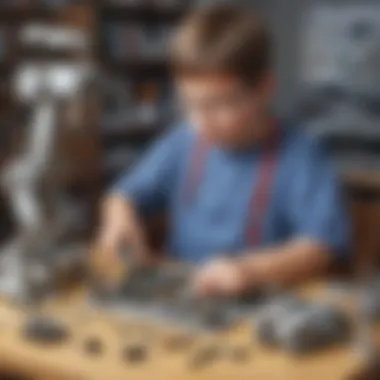Unlocking the Wonders of Robotics: A Step-by-Step Guide for Young Scientists


Science Fun Facts
Robotics, a fascinating field at the intersection of engineering and technology, offers a plethora of intriguing facts to captivate young minds. Did you know that the first robot, 'Unimate,' was used by General Motors in 1961 for tasks like lifting hot metal pieces? These mechanical marvels continue to revolutionize industries worldwide with their precision and efficiency.
Discover the Wonders of Science
Embark on a riveting journey into the world of robotics by exploring fundamental scientific concepts. Dive into educational videos and animations to unravel the principles governing robots' movements and functions. Witness the real-life applications of science through the lens of robotics, from automated manufacturing processes to sophisticated artificial intelligence systems.
Science Quiz Time
Challenge your budding expertise in robotics with interactive quizzes designed to test your knowledge. Engage in stimulating multiple-choice questions that prompt critical thinking and problem-solving skills. Delve into brain teasers and puzzles that foster a fun and educational experience, making learning about robotics a dynamic and enriching endeavor through gamification.
Science Experiment Showcase
Experience the thrill of hands-on learning with engaging robot-building experiments. Follow step-by-step instructions to construct simple bots using readily available materials. Discover the importance of safety tips and precautions while immersing yourself in the world of robotics experimentation, unleashing creativity and scientific curiosity.
Introduction to Robotics
Robotics, a field at the intersection of science, engineering, and technology, serves as a cornerstone of innovation in the modern world. In this article, we delve into the fundamentals of robotics, laying the groundwork for young science enthusiasts aged 6-12 to explore the realms of building their robot creations. Understanding the essentials of robotics is the first step towards nurturing a deep curiosity for how machines can interact with the world around them. This section serves as a launchpad for young learners to grasp the significance of robotics in shaping our future.
Understanding the Basics of Robotics
When pondering the question, “What is a robot?” we unravel a fascinating inquiry into mechanical beings designed to execute tasks autonomously or semi-autonomously, much akin to the realm of science fiction brought to life. The essence of a robot lies in its ability to function independently, following pre-programmed instructions or responding to environmental stimuli. This core characteristic makes robots indispensable in industries, space exploration, healthcare, and more. The allure of robots stems from their versatility and precision in executing tasks beyond human capacity.
History of robotics
A journey through the annals of robotics history unveils a narrative spanning centuries of innovation and ingenuity. From ancient automatons to the cutting-edge technologies of the 21st century, the evolution of robotics showcases humanity's unyielding quest to mimic and enhance nature. The historical trajectory of robotics mirrors our collective ambition to transcend human limitations, drive efficiency, and forge connections with artificial entities. By exploring the roots of robotics, we not only honor the trailblazers of the past but also gain a profound appreciation for the strides made in modern robotics.
This article discerns the pivotal role of robotics in today's world by unpacking its multifaceted applications across various industries, from manufacturing to healthcare to entertainment. Robotics holds the promise of revolutionizing processes, enhancing efficiency, and ameliorating safety standards across diverse sectors. Understanding the intrinsic value of robotics in contemporary society equips young learners with a holistic perspective on the profound impact of automation and intelligence-driven technologies.
Types of Robots
In the realm of robots, diversity reigns supreme, with each category offering distinct capabilities and functionalities tailored to specific tasks. Industrial robots, renowned for their precision and strength, dominate manufacturing floors, streamlining production processes a-amd augmenting human labor. Mobile robots, characterized by agility and adaptability, navigate dynamic environments with ease, finding applications in exploration, logistics, and service industries. Lastly, humanoid robots, bearing semblance to humans in form and movement, bridge the gap between man and machine, showcasing the pinnacle of robotics evolution.
Industrial robots stand as stalwarts of automation, embodying robustness and reliability in executing repetitive tasks with unparalleled efficiency. Their presence in factory settings underscores the transformative power of robotics in enhancing production outputs and ensuring operational excellence. While industrial robots excel in structured environments, mobile robots excel in unfettered terrains, embodying mobility and responsiveness in dynamic scenarios. From delivery drones to autonomous vehicles, mobile robots epitomize versatility and adaptability in modern robotics landscapes. On the other end of the spectrum, humanoid robots blur the lines between artificial and human intelligence, with lifelike appearances and human-like interactions defining their essence. These robots hold immense potential in healthcare, entertainment, and social robotics, ushering in a new era of symbiotic relations between man and machine.
Benefits of Learning Robotics


Embarking on a journey to master robotics offers a myriad of benefits, transcending mere technical skills to encompass cognitive and creative domains. With robotics education, children hone essential problem-solving skills, training their minds to approach challenges systematically and innovatively. The integration of programming languages into robotics curriculum fosters an early introduction to coding principles, equipping young learners with a foundational understanding of logic and algorithms. Furthermore, robotics serves as a catalyst for nurturing creativity and fostering a spirit of innovation, encouraging children to envision and actualize novel solutions to real-world problems through hands-on experimentation and design.
The allure of robotics lies in its ability to inspire curiosity, propel technological advancements, and ignite a passion for exploration in young minds. By immersing children in the realm of robotics, we sow the seeds of future innovators and problem solvers, empowering them to envision and create a world where machines and humanity coexist harmoniously. Robotics education transcends mere technical knowledge, shaping the next generation of thinkers, tinkerers, and visionaries who will propel society towards a future illuminated by the marvels of automation and artificial intelligence.
Getting Started with Building Your Robot
To embark on the journey of building your robot is a significant first step in understanding the intricate world of robotics. This section serves as a foundational pillar in our comprehensive guide, laying the groundwork for young science enthusiasts to delve deeper into the realm of robotics. Beginning with choosing the right robot kit, setting up a suitable workspace, and comprehending essential robot components, the process of building a robot encompasses various crucial elements. The importance of this segment lies in instilling fundamental knowledge and fostering curiosity, setting the stage for a fulfilling robotics experience.
Choosing Your Robot Kit
Researching various robot kits
Exploring different robot kits is a pivotal aspect of commencing your robot-building journey. By delving into the diverse array of robot kits available in the market, young enthusiasts can gain insights into the functionalities, complexities, and capabilities each kit offers. Researching various robot kits enables individuals to make an informed decision based on their interests, skill level, and desired outcomes. This thorough exploration enhances the understanding of robot components and mechanisms, laying a solid foundation for a successful robot-building project.
Considering skill level and age appropriateness
When selecting a robot kit, considering the child's skill level and age appropriateness is crucial. Tailoring the complexity of the kit to match the youngster's proficiency ensures an engaging and rewarding learning experience. By aligning the kit with the child's abilities, parents and caregivers can facilitate a smoother transition into the world of robotics, promoting confidence and skill development. Choosing a kit that strikes a balance between challenge and feasibility paves the way for a constructive learning journey.
Selecting the right components
The process of selecting the right components for your robot is a critical step in ensuring the success of your build. Each component plays a vital role in the functionality and performance of the robot, making it essential to choose components that are compatible, durable, and well-suited to the project's goals. By meticulously considering the specifications, quality, and suitability of components, young enthusiasts can construct a robot that meets their expectations and facilitates hands-on learning experiences.
Setting Up Your Workspace
Gathering necessary tools
Preparing a workspace equipped with the necessary tools is fundamental to the efficiency and organization of the robot-building process. Gathering essential tools such as screwdrivers, pliers, and wire cutters ensures that young builders have access to all required instruments to assemble their robot. Having a well-equipped workspace enhances productivity and minimizes disruptions, enabling a seamless construction experience.
Organizing workspace for efficiency
Organizing the workspace in a systematic manner is key to promoting efficiency and focus during the building process. By arranging tools, components, and work area strategically, young enthusiasts can optimize their workflow and reduce the chances of errors or misplacement. A well-organized workspace not only streamlines the building process but also cultivates good work habits that can be applied to future projects, fostering a sense of structure and discipline.
Ensuring safety precautions
Prioritizing safety precautions is paramount when engaging in hands-on activities such as building a robot. Emphasizing the importance of safety measures, such as wearing protective gear, handling tools responsibly, and working in a well-lit area, safeguards young builders from potential hazards. Ensuring that safety protocols are observed creates a secure environment for exploration and experimentation, empowering children to engage confidently in the robot-building process.
Understanding Robot Components


Motors and actuators
Understanding the functionality of motors and actuators is crucial to comprehending how robots move and interact with their environment. Motors provide the necessary mechanical power for propulsion and maneuverability, while actuators control specific movements and functions within the robot. By grasping the role of motors and actuators, young enthusiasts gain insight into the kinetic principles that drive robotics and lay the groundwork for designing dynamic and responsive robots.
Sensors
Sensors act as the sensory organs of a robot, allowing it to perceive and respond to its surroundings. By exploring different types of sensors, such as proximity sensors, light sensors, and temperature sensors, young enthusiasts can understand how robots gather data and make informed decisions. Integrating sensors into robot designs enhances their adaptability and intelligence, opening up possibilities for advanced functionalities and applications.
Microcontrollers
Microcontrollers serve as the brain of a robot, governing its decision-making processes and coordinating the operation of various components. By delving into the programming and logic behind microcontrollers, young builders can learn how to control and automate their robots' behavior. The integration of microcontrollers enables creativity and customization in robot design, empowering children to explore the intersection of coding and robotics while honing their problem-solving skills.
Assembling Your Robot
When embarking on the journey of assembling your robot, it becomes paramount to understand the intricate details that come together to bring your creation to life. Assembling a robot is not merely about putting together pieces; it is about comprehending the functionality of each component and how they synergize to perform tasks. This section focuses on the foundational process of joining motors, sensors, and microcontrollers, guiding young science enthusiasts through the meticulous steps required to build a fully operational robot.
Following Assembly Instructions
Reading the manual
'Pid thee manulae' plays a crucial role in the assembly process by providing comprehensive guidelines and insights into the robot kit's specifications. By delving into the manual, young enthusiasts can grasp the finer nuances of the components, their purpose, and their interconnections, fostering a deeper understanding of the robot's mechanics. The meticulous details outlined in the manual serve as a roadmap, ensuring a systematic approach to assembling the robot, thus enhancing the overall learning experience.
Step-by-step assembly process
'Trep-b-ytp aslebm processsg' breaks down the complex task of building a robot into manageable steps. This structured approach allows children to follow a logical progression, from assembling the chassis to connecting electronic components methodically. Each step in the assembly process is designed to build upon the previous one, instilling a sense of achievement as the robot takes shape. By following the step-by-step instructions diligently, young learners can acquire valuable problem-solving skills and attention to detail.
Troubleshooting common issues
'Tubsleshoonngiomn cmemoi para' equips young builders with the ability to identify and resolve common challenges that may arise during the assembly process. By troubleshooting issues such as misaligned connections or sensor malfunctions, children learn the importance of perseverance and critical thinking in overcoming obstacles. This hands-on experience not only enhances their technical skills but also cultivates a proactive approach to problem-solving.
Testing Your Robot
Ensuring proper wiring connections
'Ringsure porre wiing configuringsu' is a critical aspect of ensuring the smooth functionality of the robot. By meticulously inspecting and securing wiring connections, young enthusiasts mitigate the risk of electrical shorts and component damage. Understanding the significance of proper wiring not only promotes the robot's performance but also instills a sense of precision and attentiveness in young builders.
Calibrating sensors


To catapult your robot's performance to the next level, 'Cbrialatng semi' entails fine-tuning sensors to interact accurately with the environment. By calibrating sensors meticulously, children learn the importance of sensor accuracy in enabling the robot to perceive and respond to its surroundings effectively. This hands-on calibration process enhances their grasp of sensor technology and its implications in robotics.
Programming basic movements
Embracing the realm of 'Porgamnmiph basix memotvnss' enhances young enthusiasts' programming skills as they impart basic functionalities to the robot. By coding essential movements such as forward, backward, and turns, children delve into the core principles of programming logic and sequential commands. Programming basic movements not only brings the robot to life but also ignites a passion for creative exploration in the field of robotics.
Fine-Tuning and Personalizing Your Robot
Adding custom features
'Addin cust poorer featusos' permits young builders to inject their creativity and innovation into the robot's design. By incorporating unique features such as LED lights or additional sensors, children personalize their creations, making them distinct and reflective of their imaginative flair. Adding custom features not only amplifies the robot's functionality but also nurtures a sense of ownership and pride in the young engineer.
Decorating your robot
Embarking on the journey of 'Decroatingg tooorbu' allows children to infuse personality and character into their robotic companions. By embellishing the robot with colors, stickers, or imaginative decorations, young enthusiasts transform mere machines into personalized companions. Decorating the robot not only showcases individuality but also fosters a sense of attachment and emotional connection to the creation.
Experimenting with different functionalities
'Dosperta harmmerrii woo disjoint functionallyt' encourages children to explore the diverse capabilities of their robots beyond basic operations. By experimenting with functionalities such as obstacle avoidance or sound detection, young engineers push the boundaries of creativity and problem-solving. This experimental phase not only expands their technical prowess but also cultivates a mindset of curiosity and innovation in approaching robotics projects.
Exploring Further Robotics Projects
In this comprehensive guide on building a robot for young science enthusiasts, delving into further robotics projects becomes a crucial element. Understanding advanced robotics concepts opens up a world of possibilities for young learners. By exploring beyond basic robot assembly, children can grasp the intricate technologies that drive modern robots. This section aims to instill a deep appreciation for the complexities of robotics, inspiring curiosity and a hunger for knowledge. Advanced robotics concepts lay the foundation for future innovation and breakthroughs.
Advanced Robotics Concepts
Artificial intelligence in Robotics
Artificial intelligence (AI) in robotics marks a significant advancement in automation. AI enables robots to learn from experience, adapt to new situations, and perform tasks with precision. Its integration into robotics adds a layer of sophistication, allowing robots to analyze data, make decisions, and operate autonomously. In this guide, AI in robotics stands out as a key focus to introduce young learners to cutting-edge technology.
The unique feature of AI lies in its ability to mimic human intelligence, enhancing robots' problem-solving and decision-making skills. However, AI's complexity may present challenges in implementation, requiring careful programming and testing. Despite its intricacies, AI brings unparalleled efficiency and accuracy to robotic systems, making it a valuable tool in this educational journey.
Autonomous Navigation Systems
Autonomous navigation systems empower robots to navigate and move independently without constant human intervention. These systems rely on sensors and algorithms to perceive the environment, plan routes, and avoid obstacles. Introducing young minds to autonomous navigation sheds light on the integration of sensory feedback and computational algorithms within robotics.
The key characteristic of autonomous navigation systems is their ability to enhance a robot's freedom of movement and decision-making capacity. By incorporating such systems, robots can explore unknown terrains and execute complex tasks with ease. However, challenges such as sensor calibration and environmental variability may impact their efficiency, posing learning opportunities for aspiring roboticists.
Robotics in Different Industries
The application of robotics extends beyond traditional fields, infiltrating various industries such as healthcare, manufacturing, and agriculture. Understanding robotics' role in different sectors highlights its versatility and real-world impact. This guide introduces young learners to the diverse applications of robotics, stimulating innovative thinking and problem-solving skills.
The key characteristic of robotics in different industries is its capacity to streamline processes, increase productivity, and enhance safety standards. By incorporating industry-specific examples, children can envision the transformative power of robotics in shaping the future workforce. Despite its advantages, adapting robotics to specific industries may require tailored solutions and continuous evolution to meet industry demands.







